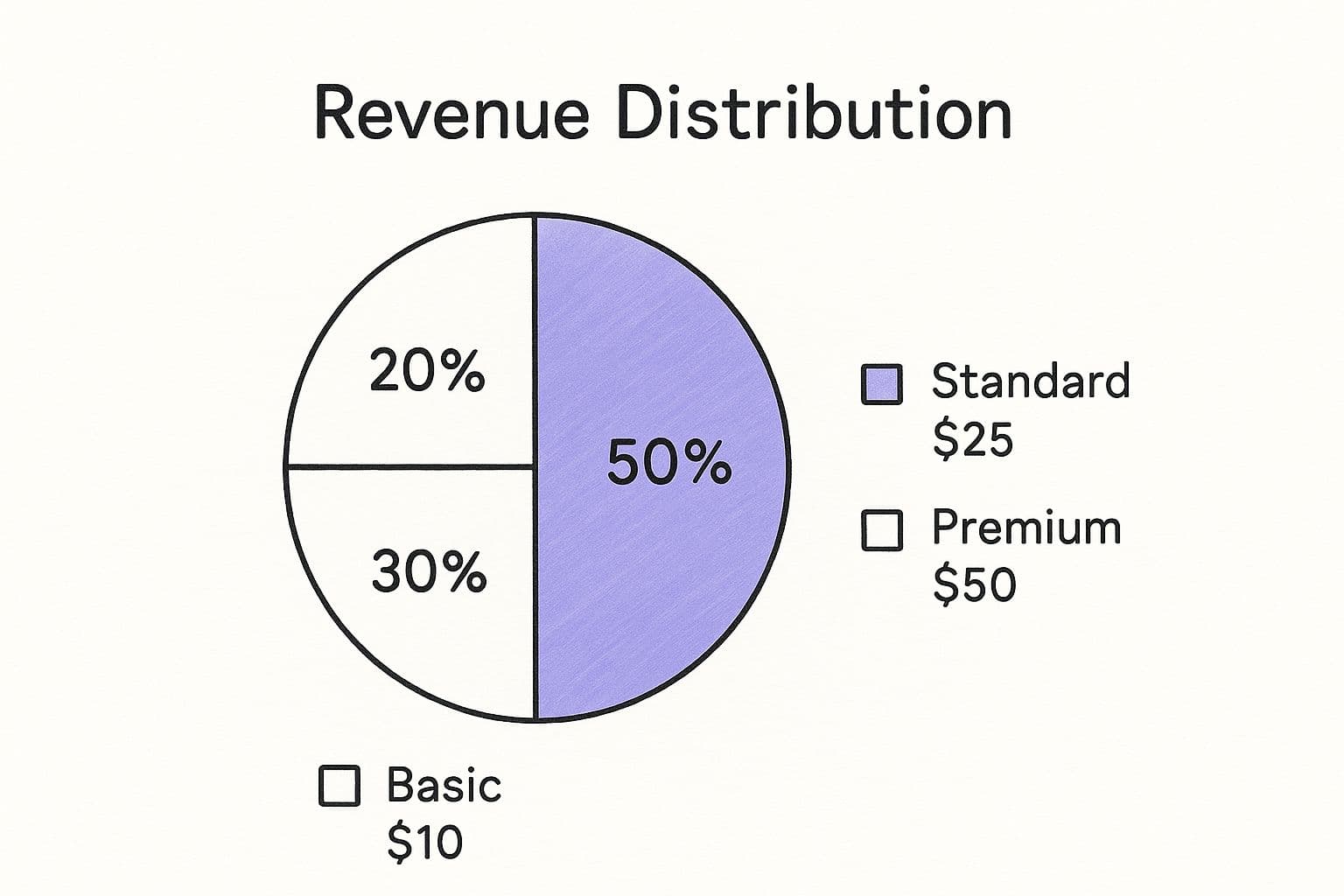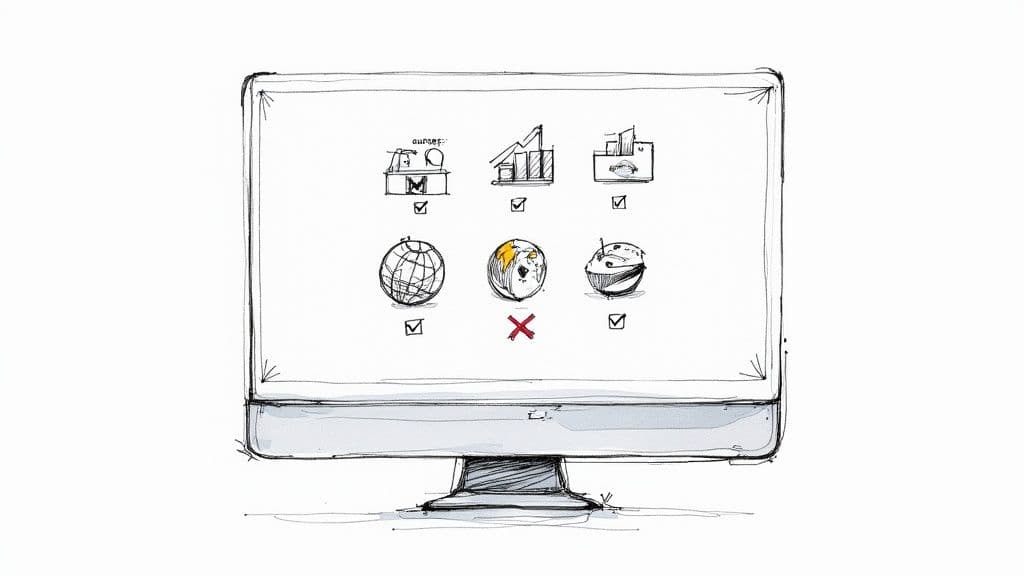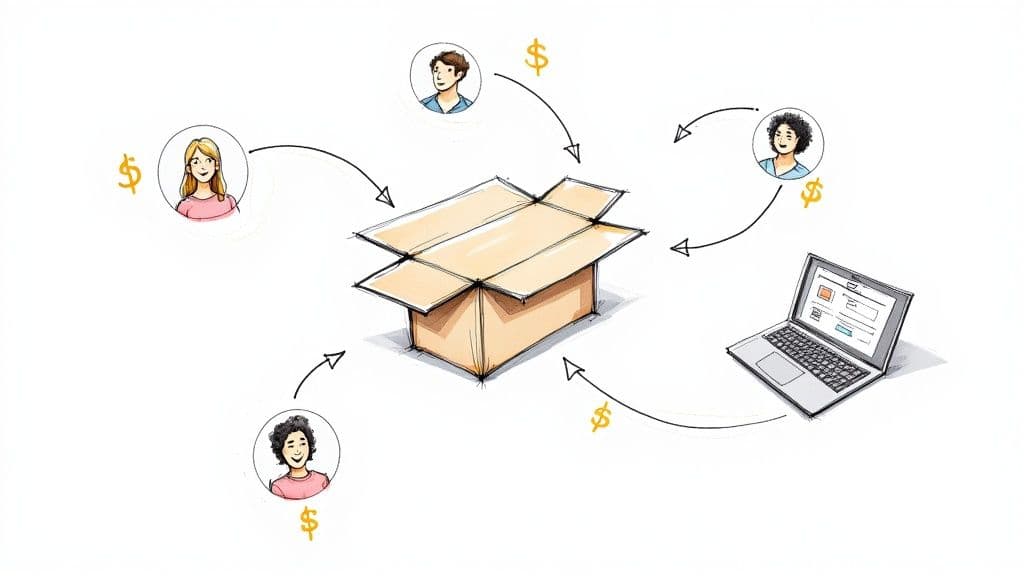Subscription services have completely changed how we buy things and access content. Instead of chasing one-off sales, this model is all about building real, ongoing relationships with customers. The result? Predictable income and deep-seated loyalty.
Honestly, starting a subscription-based business is one of the most resilient moves an entrepreneur can make right now.
Why Subscription Models Are a Game Changer
Switching from single sales to recurring revenue isn’t just some passing fad; it’s a strategic pivot towards a more sustainable, customer-first way of doing business. The biggest pull? Predictability.
Forget the traditional retail rollercoaster where you're constantly hunting for the next sale. A subscription base gives you a stable, recurring income stream you can actually count on month after month.
This stability completely transforms how you operate. It means you can forecast your finances more accurately, manage your inventory without the usual guesswork, and invest in growth with confidence. Knowing roughly what’s coming in de-risks a huge part of running a business.
Which Subscription Model Fits Your Idea?
Before you dive in, you need to pick the right foundation. Most successful subscription businesses fall into one of three buckets. Choosing the right one for your idea is the first—and most important—step.
| Model Type | Best For | Core Benefit |
|---|---|---|
| Curation | Discovery-focused products like artisanal foods, beauty boxes, or book clubs. | Delight & Surprise. Customers pay for your expert taste and the thrill of unboxing something new and exciting. |
| Replenishment | Everyday essentials that people use regularly, like coffee, vitamins, or pet food. | Convenience & Automation. You save customers time by putting their routine purchases on autopilot. |
| Access | Exclusive content, communities, software, or members-only perks and pricing. | Exclusivity & Value. Members pay for entry into a private world of content, community, or savings. |
Each model serves a different customer need, from the convenience of "set it and forget it" replenishment to the joy of a curated surprise. Nail this choice, and you've built your business on solid ground.
Unlocking Higher Customer Value
One of the biggest wins here is the massive jump in Customer Lifetime Value (LTV). Everyone knows it costs a fortune to get a new customer compared to keeping an existing one. Subscriptions are literally built on retention, turning a single transaction into a long-term relationship.
This recurring model creates a powerful feedback loop. With every delivery or renewal, you learn more about what your customers love, letting you tailor their experience and lock in their loyalty. Happy, long-term subscribers also tend to become your most vocal brand advocates.
Tapping into Modern Consumer Habits
Today’s shoppers are all about convenience, curation, and value. Subscription models hit all three, offering:
- Convenience: Automating the re-ordering of things they use all the time, like coffee or vitamins.
- Curation: Delivering new and delightful experiences, like a hand-picked box of craft beer or beauty products.
- Access: Providing an exclusive key to content, communities, or special member pricing.
The market growth proves this isn’t just a theory. The UK subscription box market alone is projected to be worth £1.8 billion by 2025, with food-related boxes dominating the scene. This signals a huge opportunity for entrepreneurs ready to meet that demand for convenience and discovery. You can dive deeper into these subscription service statistics and see the full breakdown.
Ultimately, when you're starting a subscription-based business, you’re not just selling a product; you’re selling an ongoing experience and a direct relationship. That connection gives you incredible insight and control, creating a rock-solid foundation for success.
Finding an Idea Worth Subscribing To
Every killer subscription service starts with one thing: a fantastic idea. But let’s be real, a great idea isn't just about being unique. It's about solving a genuine problem or fulfilling a deep desire so well that people are happy to pay you for it every single month.
The key to a subscription business that actually lasts is to move beyond vague brainstorming and pinpoint a gap in the market that you are perfectly positioned to fill.

038bc13c-9b44-4f7b-8e2f-16280fc56002.jpg
Honestly, the best ideas often come from scratching your own itch. What frustrates you? What service do you wish just existed already? If you're passionate about a specific hobby, like home brewing or collecting vintage comics, you’ve got an insider's view on what that community really wants and needs. That personal insight is your most valuable asset.
But passion alone won't pay the bills. You have to confirm that other people share your problem and, crucially, are willing to open their wallets for a solution.
Uncovering Market Gaps and Pain Points
Your future customers are already talking about their problems online. You just need to know where to listen.
Get in there and scour forums, Reddit threads, and Facebook groups related to your area of interest. What are the common complaints? What questions get asked over and over again? These are massive clues pointing directly to unmet needs.
For example, a fitness coach might notice beginners in a weightlifting forum constantly asking for feedback on their form because they're too intimidated to ask at a commercial gym. That’s a massive gap in the market, pointing to a subscription service that offers personalised form-checks via video alongside a supportive online community.
Key Takeaway: Don't invent a problem to solve. Find an existing, nagging pain point that people are actively trying to fix. Your business just needs to be the most convenient and effective solution they can find.
Another solid technique is to analyse your potential competitors. Don't just look at what they do well; zoom in on what they don't do. Go read their one-star reviews. Disappointed customers will literally hand you a blueprint for a better offer.
Maybe a popular snack box has great variety but totally ignores people with dietary needs like gluten-free or vegan. Boom. That's your opening.
Testing Your Idea Without Breaking the Bank
Okay, so you’ve got a promising idea. Now you need proof that it has legs before you sink serious time and money into it. This validation stage is what separates successful businesses from expensive hobbies. The goal is to get a clear "yes" from the market.
Here are a few low-cost ways to validate your subscription concept:
- The Landing Page Test: Whip up a simple one-page website that clearly explains your subscription offer. Describe the value, show some mock-ups, and have a clear call-to-action like "Join the Waitlist" or "Get Notified at Launch." Then, drive a bit of traffic to it with a small, targeted social media ad budget. A healthy number of email sign-ups is your first proof of interest.
- Run Targeted Polls: Use Instagram Stories, Twitter polls, or pop a survey in relevant online groups. Ask direct questions about your proposed service and pricing. Something like: "Would you pay £15/month for a curated selection of rare indoor plant cuttings?" The responses give you instant, real-world feedback.
- Offer a Founder's Pre-sale: This is the ultimate test. Offer a limited number of "founding member" spots at a hefty discount. This not only proves people will actually pay for it, but it also generates some initial cash to fund your first product run or content batch.
Finding the right idea is a process of listening, observing, and testing. It’s all about matching a real market need with your own passion and expertise. For a bit more inspiration, it's worth exploring the wide world of successful subscription business model examples to see how others have carved out their own profitable niche.
Designing Your Offer and Pricing It Right
Your subscription offer is the absolute heart of your business. It's not just the product or content you deliver; it's the entire package that convinces someone to become a paying member and—more importantly—to stick around.
Nailing your offer and pricing is a delicate balance. It's part art, part science. But getting it right is probably the most critical part of building a subscription business that actually lasts.
This isn't about plucking a number out of thin air. It’s about building an offer so irresistible that joining feels like an obvious choice, not a tough decision. When you get the value proposition right, the price becomes a secondary thought.
Structuring Compelling Subscription Tiers
One-size-fits-all rarely works in the real world. A much smarter move is to create tiered membership levels. This lets you cater to different customer needs and budgets, widening your net to catch everyone from the curious beginner to the hardcore enthusiast.
Think of it like this:
- The Entry-Level Tier: This is your low-barrier, easy-yes offer. It might include access to a general community channel on Telegram or a weekly newsletter. The goal is simple: get people in the door so they can experience your value without a scary commitment.
- The Standard Tier: This is your sweet spot. It's where the bulk of your members will probably land because it delivers the full experience and solves the main problem your subscription is built around. For a fitness coach, this tier would likely include workout plans, community access, and weekly Q&A sessions.
- The Premium Tier: This one’s for your superfans. It’s everything in the standard tier plus exclusive perks like one-on-one coaching, early access to new material, or even direct messaging support. It’s a higher-priced, higher-touch option for your most loyal members.
This tiered approach is a fantastic way to maximise your revenue. In fact, you'll often find the middle tier becomes the financial engine of your entire business.

7363f9b6-de5d-4a32-b04d-58f18ba75d4f.jpg
As you can see, the 'Standard' tier often drives the majority of revenue—50% in this example. It highlights how a balanced structure, not just a high-priced premium offer, is what really builds a sustainable income.
Choosing the Right Pricing Strategy
Once you’ve got your tiers sketched out, you need to decide how to charge for them. The strategy you pick should directly mirror the value you're providing. When you're designing your offer, it's crucial to explore various pricing models to find the one that aligns with your value proposition and audience.
The best pricing feels fair to the customer because it’s directly tied to the value they receive. If your members feel they're getting more value than what they're paying for, they'll stick around for the long haul.
Some common strategies you’ll see are:
- Flat-Rate Pricing: One price for one set of features. It’s simple, predictable, and incredibly easy for customers to understand. This is perfect for content libraries, newsletters, or community access where everyone gets the same core value.
- Per-User Pricing: You'll see this a lot in B2B or software settings, where the cost scales with the number of people on an account.
- Usage-Based Pricing: Here, the cost is tied to how much of the service a customer actually uses. This is less common for creator-led subscriptions but could work for things like API access or data processing services.
For most creators launching a subscription business, a combination of tiered levels with flat-rate pricing for each is the most effective and straightforward path. It just makes sense.
If you want to go deeper on this, check out our complete guide to building a winning subscription pricing strategy. It'll help you lock in the best choice for your business.
Ensuring Your Pricing Is Profitable
Getting popular is great, but profitability is what keeps the lights on. Before you finalise any prices, you have to get real about your costs—and I mean all of them, not just the obvious ones.
Here's what you need to calculate:
- Cost of Goods Sold (COGS): For physical products, this is easy—it’s the cost of the items in your subscription box. For digital creators, think of this as your software subscriptions, hosting fees, or any tools you use for content creation.
- Platform & Transaction Fees: Every payment processor and membership platform will take a small slice. Platforms like MyMembers integrate with Stripe, for instance, which has its own transaction fees. Don't ignore these.
- Marketing & Advertising Costs: How much will it cost you to get each new subscriber through the door? Factor that in.
- Your Time: This is the one everyone forgets. Don't forget to pay yourself! Calculate a realistic hourly rate for the time you pour into creating content and managing your community.
Add all those costs up to find your break-even point. Your pricing absolutely must sit comfortably above that number to ensure you have a healthy profit margin. A good target to aim for is at least 40-50%—that’s what builds a business that can weather the ups and downs.
Choosing Your Subscription Technology Stack

ec8021ab-6b76-4fa4-84f0-0c280ab3c602.jpg
The tech you choose is the engine room of your subscription business. Get it right, and it just hums away in the background, handling all the fiddly, repetitive tasks while you focus on your members.
Get it wrong? You’ll spend all your time fighting technical fires instead of actually growing your business. It's a massive, and completely avoidable, headache.
When you're starting a subscription-based business, you've basically got two paths for your technology. Each has its pros and cons, and the right one for you boils down to your technical confidence, budget, and long-term vision.
All-In-One Platforms vs A Custom Stack
Your first big decision: use a dedicated, all-in-one platform or try to piece together your own custom solution from different specialised tools.
An all-in-one platform, like MyMembers, is built specifically for this business model. It bundles everything you need—from landing pages and payment processing to member management—into a single, unified system. This is almost always the best choice for creators who want to get up and running fast without touching a line of code.
A custom stack, on the other hand, means connecting separate services. You might use a generic website builder, plug in a separate payment gateway, connect a third-party email service, and then pray they all talk to each other correctly. This approach offers ultimate flexibility but demands serious technical skill and constant maintenance.
For most new entrepreneurs, an all-in-one platform is the smarter, more efficient route. It removes the technical headache and allows you to concentrate on what you do best: creating value for your subscribers. The time saved on setup and troubleshooting is invaluable.
Think of it like building a car. You could source the engine, chassis, and electronics yourself and assemble it from scratch. Or, you could get a fully built, reliable car straight from the factory, ready to drive. Both get you on the road, but one journey is a whole lot faster and less stressful.
Identifying Your Non-Negotiable Features
Regardless of the path you choose, there are a few core features your tech stack absolutely must have to run a subscription business. These aren't just nice-to-haves; they are the fundamental mechanics that make recurring revenue possible.
You'll need a system that expertly handles:
- Secure Payment Processing: This is the heart of your operation. Your platform needs to reliably and securely handle recurring payments through a trusted gateway like Stripe. No messing about.
- Automated Billing & Invoicing: Manually sending invoices each month is a non-starter. The system must automatically charge members based on their billing cycle and send them receipts without you lifting a finger.
- Dunning Management: What happens when a payment fails? Dunning is the process of automatically retrying failed payments and notifying the customer. This single feature can recover a huge amount of otherwise lost revenue. It’s a game-changer.
- A Self-Service Customer Portal: Members need to be able to update their payment details, change their plan, or cancel their subscription without emailing you. This empowers them and saves you countless hours of admin.
Platforms like MyMembers are built around these essentials, giving you a rock-solid foundation from day one. Trying to build this functionality yourself would be a massive, and frankly unnecessary, undertaking for most people.
Making the Right Choice for Your Business
So, how do you decide? Let's look at a couple of real-world scenarios.
Imagine you're a fitness coach wanting to sell access to a private Telegram group with workout plans and Q&A sessions. Your main goal is to launch fast and manage members easily. For you, an all-in-one platform is a perfect fit. You can set up your offer, create a landing page, and connect your Stripe account in an afternoon.
Now, picture a huge enterprise with a team of developers that needs a completely bespoke subscription service integrated into its existing, complex software. In that case, a custom-built stack might be the only way to meet their unique requirements.
The outlook for subscription services remains incredibly strong. By 2025, consumer engagement is expected to hold firm, with 80% of UK consumers planning to either keep or increase their subscriptions. This resilience shows just how important it is to pick a dependable tech foundation that can support that growth. If you want to dive deeper, you can discover more insights about the future of UK subscriptions on clusters.uk.com.
Choosing your technology isn't just a technical decision; it's a strategic one. For most people starting a subscription-based business, the right choice is one that simplifies operations, minimises admin, and gives you the freedom to build a thriving community.
Getting Your First 100 Subscribers
Okay, you've got the tech sorted. Now for the fun part: getting people to actually sign up.
Landing your first 100 subscribers is a massive milestone. Forget the revenue for a second—this is about validation. It's proof that people want what you're selling. It builds the social proof and momentum you need to go from a side project to a real business.
Getting to 100 is a completely different game than scaling to 1,000. This isn't about broad, flashy marketing. It's about rolling up your sleeves and doing things that don't scale. Your goal is to find your founding members—the true believers who get your vision and will become your best source of feedback and referrals.
Build Hype Before You Even Launch
The real work starts long before your doors are officially open. A killer pre-launch campaign builds a runway of eager customers, so you don't launch to the sound of crickets. It’s all about creating buzz and a bit of FOMO.
Your number one tool here is a waitlist. Get a simple landing page up that nails your value proposition and has a clear email sign-up form. This isn't just a list; it's the seed of your community.
To get people on that list, you need to generate some heat:
- Share behind-the-scenes dirt: Post sneak peeks of your product, your messy creative process, or the story behind your brand. Make people feel like insiders on the journey with you.
- Hang out where your people are: Jump into forums, subreddits, or social media groups where your ideal customers live. Don't just spam your link. Offer real value, answer questions, and only mention your upcoming launch when it feels natural.
- Run a countdown: As launch day gets closer, use social media stories and email updates to build urgency. Make it feel like an event people don't want to miss.
For subscription businesses, getting your social media game right is non-negotiable for snagging those first users. Good social media growth strategies are one of the most direct ways to fill your pre-launch waitlist and generate that early buzz.
Create an Early-Bird Offer They Can't Refuse
Your first members are taking a leap of faith. You need to reward them with something that makes them feel like a big deal. A generic "10% off" coupon just won't cut it. You need something special.
Think about offering a Founder's Rate. This is a lifetime discount that only your first 50 or 100 subscribers will ever get. It creates powerful scarcity and turns your early adopters into proud, loyal advocates. They’re not just customers; they’re founders.
Your early-bird offer shouldn't just be a discount; it should be a status symbol. Frame it as a one-time opportunity to get in on the ground floor, locking in a privileged price forever. This approach fosters a deep sense of loyalty from day one.
Another powerful move is to bundle in exclusive bonuses that disappear after the launch. This could be a 1-on-1 call with you, extra digital content, or even a physical gift in their first box. The goal is to add so much value that joining right away becomes a complete no-brainer.
Keep the Momentum Going with Sustainable Growth Tactics
Once you've launched and your founding members are in, your strategy has to evolve. The early-bird offer gave you that initial push, but now you need a steady stream of new subscribers.
Here’s what works now:
- Content Marketing That Establishes You as an Expert: Regularly create genuinely useful content—blog posts, video tutorials, or insightful guides—that solves problems for your target audience. This builds trust and makes your subscription the logical next step for anyone benefiting from your free stuff.
- Targeted Social Media Ads: Use the data from your first subscribers to create lookalike audiences for paid ads. Instead of a "spray and pray" campaign, run highly targeted ads on platforms like Instagram or Facebook, sending traffic straight to your sign-up page. Start with a small budget, see what hits, and then scale it.
- Launch a Simple Referral Programme: Turn your happiest customers into your best salespeople. Offer a real incentive—like a free month or a special discount—for every new member they bring in. Word-of-mouth from your most passionate advocates is one of the most cost-effective ways to grow.
Keeping Subscribers Happy and Reducing Churn

4800f0ec-79fa-4720-9f28-f067b19fb995.jpg
Getting a new subscriber feels great. But the real secret to a profitable subscription business? Keeping them.
Customer churn—the rate your members cancel—is the silent killer of recurring revenue. It's the leaky bucket that drains your hard-earned gains. Honestly, mastering retention is what separates the flash-in-the-pan businesses from the ones that stick around for the long haul.
Your fight against churn starts the second someone signs up. Those first few days are your golden window to make them feel welcome, kill any buyer's remorse, and show them exactly how to get value from their subscription. A solid onboarding experience isn't just nice to have; it's non-negotiable.
Design a Memorable Onboarding Experience
A great welcome doesn't need to be complex. It’s about making a human connection and giving clear, proactive guidance. A simple, automated email series can do wonders here.
Your onboarding should nail a few key goals:
- Make it Personal: Send an immediate, warm welcome email that feels like it’s from you, the founder. Thank them for joining and share your genuine excitement.
- Give Clear Next Steps: Tell them exactly what to do first. Should they join the community? Watch a specific video? Help them score an instant win.
- Showcase the Value (Again): Over the first week, drip-feed them tips, highlight killer features, or share success stories from other members. Keep reminding them they made a smart choice.
Consistently Deliver and Exceed Expectations
At its core, retention is simple (but not easy): consistently deliver on your promise. If your subscribers feel they're getting more value than what they pay for, they'll have no reason to leave. This means staying plugged into their needs and constantly improving what you offer.
Regularly ask for feedback. Use simple surveys or just be active in your community. What do they love? What could be better? This direct line to your customers is your best defence against churn. For any subscription business, learning how to reduce customer churn is a fundamental skill for long-term survival.
The reality is that keeping customers is more critical than ever. With economic pressures mounting, 90% of UK subscription retailers are now prioritising retention. Why? Because customer acquisition rates have slumped from 4.1% in 2021 to just 2.8% in 2024.
For a deeper dive into practical retention tactics, check out our guide on how to reduce your churn rate. It’s packed with actionable steps you can use today to keep your members happy, engaged, and paying. Building that loyal base is the ultimate key to a healthy, growing subscription business.
Got Questions? We've Got Answers
Stepping into the world of subscription businesses, you're bound to have questions. It's totally normal. Here are some quick, no-fluff answers to the queries we see pop up most often from entrepreneurs just like you.
How Much Cash Do I Really Need to Start?
Honestly, it varies wildly depending on your big idea.
If you're launching a digital-only subscription – think a premium newsletter or exclusive community access – you could get off the ground with just a few hundred quid. That'll cover your basic platform fees and a small marketing push.
But a physical subscription box? That's a different beast entirely. You've got to factor in sourcing products, getting custom-branded packaging printed, and covering your first round of shipping.
A smart move we've seen work time and time again is to pre-sell your first month's box to a group of founding members. This isn't just a strategy; it's a lifeline. It can fund your initial inventory and slash your upfront risk, potentially bringing your startup cost down to a few thousand pounds instead of tens of thousands.
What Legal Stuff Should I Be Worried About?
Right, the boring but essential bit. Your top priorities are your Terms of Service and your Privacy Policy.
Your Terms of Service need to be crystal clear about your cancellation and refund policies. Make sure they line up with the UK's Consumer Rights Act. No grey areas. Your Privacy Policy needs to be GDPR-compliant, which is non-negotiable the second you start handling any customer data.
Look, if you’re selling physical goods like food or cosmetics, you're playing in a different league. You have to nail the specific product safety and labelling regulations. Seriously, talk to a legal expert to make sure you're buttoned up from day one. It's an investment that pays for itself.
How Do I Handle Shipping and Logistics in the UK?
Most UK startups kick things off with Royal Mail. It's reliable, has massive coverage, and it's a name people trust. It just works.
As your subscriber count climbs, you'll likely find that courier services like DPD or Evri start looking more attractive. They often offer more competitive rates for bulk shipping and much better tracking, which your customers will love.
At the start, packing boxes yourself in your living room is the most cost-effective way to go. It's a rite of passage. But once you hit a certain number of subscribers, outsourcing fulfilment to a third-party logistics (3PL) partner can be a complete game-changer. It frees you up to stop managing tape guns and start focusing on what actually grows the business.
Ready to turn your Telegram community into a real, recurring revenue stream? MyMembers is a no-code platform that lets you handle payments, members, and landing pages without the headache. Start building your subscription business today at mymembers.io.
